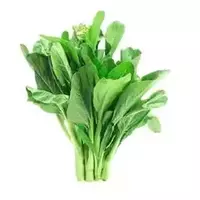Leaf mustard

The homeland of leaf mustard, which is also called lettuce, is considered China - there it can still be found in the wild. However, unfortunately, this aromatic plant has not taken root in our gardeners and gardeners, although it can be grown everywhere in Russia.
Leaf mustard is an annual herbaceous plant that belongs to the cruciferous family. It is distinguished by rather large leaves of various shapes, which are covered with slightly spiny hairs. Basal petiole whole leaves of leaf mustard form a large rosette. Individual varieties of leaf mustard are characterized by wavy and very dissected leaves. Some Japanese varieties of leaf mustard can reach up to 60 centimeters in length, while domestic ones look much more modest.
Leaf mustard is a cold-resistant precocious plant, which, less than a month later, at the moment of planting seeds, gives young tender leaves. A distinctive property of leaf mustard is that the plant is unpretentious to the soil and frost-resistant. So, its seeds are able to germinate even at a temperature of about 1-2 ° C. The plant is not demanding of moisture, but systematic watering is necessary to obtain a good crop of greens.
It is noteworthy that there are not so many varieties of leaf mustard. In vegetable gardens and gardens, as well as on the shelves, there are varieties of Salad 54, Voloschushka (the most common), Krasnolistnaya and Skoropelaya. The most popular variety of leaf mustard - Voloschka - is distinguished by a slightly spreading rosette of leaves, the diameter of which is up to 25 centimeters. The leaves of the plant have a light green color and an elongated oval shape. The taste of this variety of leaf mustard is fresh, slightly savory - the plant is used mainly for making green salads.
In a surprising way, leaf mustard combines the tastes of mustard, salad and horseradish. It is thanks to this property of leaf mustard that it has a savory tender taste and can perfectly replace liquid mustard. By the way, mustard leaves are used independently raw as a fresh salad or mixed with other types of greens. Once heat-treated, the leaf mustard is perfectly suited for serving as a side dish to fish and meat dishes.
The beneficial properties of leaf mustard are due to the rich content of vitamins A, C, group B, K, E and PP. There are carotene and mineral salts in its leaves, which are so necessary for the human body, especially in the Middle Urals. The leaves of young plants contain a considerable amount of mustard oil. Leaf mustard is distinguished by its ability to arouse appetite and increase the secretion of gastric juice. In addition, its benefits as a natural antiseptic and anti-inflammatory are known.
26 kCal leaf mustard
Energy value of leaf mustard (Ratio of proteins, fats, carbohydrates - ju):
Proteins: 2.7 g (~ 11 kCal)
Fats: 0.2 g (~ 2 kCal)
Carbohydrates: 1.6 g (~ 6 kCal)
Energy ratio (bj | y): 42% | 7% | 25%
 Español
Español Français
Français Português
Português Русский
Русский 简体中文
简体中文 繁體中文
繁體中文 日本語
日本語 한국어
한국어 العربية
العربية Türkçe
Türkçe Қазақ
Қазақ Deutsch
Deutsch Italiano
Italiano Українська
Українська
